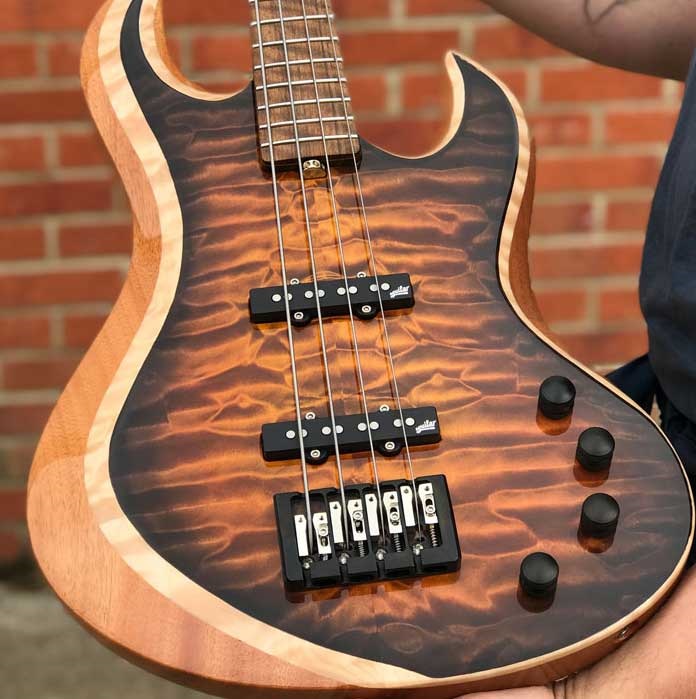Can you believe the above instrument was built for $200 AUD? Believe it. Pete tells his build story below.
I’m a church pastor and I play every week at church. A few years back I decided I wanted a custom 6 string headless. I couldn’t afford to buy such a bass, so a friend got me started building basses.
For the last few years I’ve been building for family and friends to get good enough to build the custom 6 string I wanted. I was ready to build the bass last year. I had all the hardware but just needed pickups. Having ordered some from a custom builder I was getting fluffed around. I was feeling down about the situation, so I thought, “why not build yourself a fretted 6 string in mean time with scraps and left overs?”.
I build using sustainable local Australian timbers and scavenged/salvaged timbers. I went through my timber pile and came up with the following for the bass. Top; silky oak double bookmatched top – from a nasty old panel of silky oak I couldn’t bear to throw out. Silky oak is impossible to find and the grain in the panel was so good. Core; kauri pine – two leftover from another project. They come from a an Sunday school bench given to me by a local church.
Back; Mango wood panels; These two panels came from an old desk some friends gave to me a little while back.
Neck; Tasmanian oak/ red dyed maple stripe/ black dyed maple back headstock veneer/silky oak headstock face;
The oak and maple veneers are all leftovers that needed some TLC before being used. The body is a three piece sandwich.
The pine was heavily chambered before being glued to the top and back. The only areas the bass isn’t hollow are around the cutaway and the centre strip. This was to help keep the weight down and promote resonance. I’m a big fan of lighter basses help players be comfy on longer gigs. I also think a lighter bass is a more resonant bass.
The shape is based on an O style resonator body with my own mods and Venetian cutaway. I used the body shape for a baritone I built last year for my twin brother’s 40th birthday. I liked the aesthetic so much I used it with this bass.
I’ve scalloped the cutaway for better access to the upper frets.
The neck is a three piece construction with two pieces of Tassie oak and red dyed maple.
The fingerboard is also Tassie oak from an old plank I had from the local hardware. The headstock is a standard scarf joint. It has a stewmac hotrod single trussrod. The board has a 20″ radius and used wide/medium frets.
The neck profile is where it gets interesting. It’s flat plains like a trapezoid. It looks odd, but I’ve found it to be both extremely stable and quite comfy. It seems counter intuitive, but it works really well. It’s held onto the body with a high access bolt on joint and 8 screws.
You’ve probably also noticed it’s multiscale. I did this because I wanted the playability of shorter scale but a B string that worked properly.
I’ve build 3 32″ scale basses so far and all of them were a joy to play. So the B is 33″ scale and the high C is 31″ scale. While the measuring out hurt my eyes it was worth the hard work. I’m still getting used to playing it, but the B string is nice and taut (0.135″ gauge) and the bass is still nice and compact. It’s about the same length as a dreadnought guitar and fits in a classical guitar gig bag.
This is a budget bass so all the hardware on the bass is budget hardware from ebay. The tuners are Art Deco style sealed Wilkinson guitar tuners. The bridge is made of single bridge elements. The nut is a home made laminate of recycled piano key ivory veneers given to me by a friend and black and red dyed maple veneer.
The electronics are pretty simple unique. The Wilkinson MM6 pickup is passive. It has a kill switch for both coils to run them individually or in parallel. It also has a series switch. These feed into master volume and tone dials. The dials and knobs came from my local electronics hobby store.
Overall I’m pretty pleased with how it’s come out. It’s cost me about $200 to build all up. It’s not perfect but it’s pretty much the best thing I’ve build so far. I was a little concerned that the tone wouldn’t be flexible enough for jazz, but a visit to a Jazz jam night has removed that fear.
Now all I have to do is get used to playing it. It is pretty light, balances well and has a nice sound across the whole instrument.
https://soundcloud.com/simpleinnovation/simple-innovation-bass-008
Cheers,
Pete
Sydney, Australia




















I don’t think anyone could have done any better for $200 AUD. Well done, Pete!
Want to have your bass featured for Bass of the Week?
Submit yours right now




Great job! I’ve always wanted to do build my own as well.
A truly impressive work. A proof of what one can achieve with hard work and dedication. I’m a fan of short scaled basses too!
Wow, very cool! Would love to hear it in a vid,
Not trying to be critical – but shouldn’t the nut be fanned to match the fanned frets? Nice woodworking.
It is not necessary in his case, because he is using zero fret (the very first fret). The nut is only acting as a string holder, so all notes will still be in tune.
Zero fret…..
Awesome. Nice punchy tone.
Wood is not expensive. Hardware is expensive.
Seriously. If those are ABM single-string bridges, just those cost more than 200$.
All the hardware is Chinese off ebay. I couldn’t afford anything that good for this unfortunately. I dare you to pick the difference in sound though. 😉
Pete
I know silky oak as Lacewood, and it is my favorite tone wood ever. My guitars and basses of that wood are my favorite to play, and also to look at, being so beautiful. Nice work on the build! Love the fanned frets.
Great job Pastor!
impressive, i like that bass.your mail please…want to talk a lot.
More builds like this one! Deeply cool. How about a contest?
nice looking bass…I wonder how much the equipment/tools needed to build such a bass…costs?
That’s awesome! Can you build one 4 me?